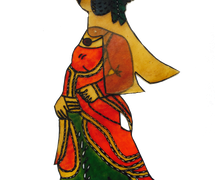

998) of the presence of shadow theater in Iraq, the poet Daabal Al Khuzai (865-960), has threatened one of Al-Ma’mun (the Abbasid caliph) cooks that if he satirized him he would “ get his mother on a shadow theater show“. In the 9 th century: There is an indication in the book of As Shabushti “Ad Diyarat” (d.Al Masbahi (977-1029) also describes a shadow theater show in Egypt saying: “ People in Egypt usually go out on holidays and parade in the streets holding figures and puppets“. Al Ghazali (1059-1111) and Abul Alaa’ Al Maarri (973-1157), in some of their writings, describe their impressions of a shadow play. Faruk Saad named it “ The mechanical shadow theater“. This important reference to shadow theater in Al Andalus denotes a developed type of Shadow Theater known at that time. In the 11 th century: Ibn Hazm (994-1064) described a shadow play as follows: “I have never seen anything more lifelike than the shadow theater, with its actors mounted on wooden handles that are turned rapidly so that some disappear and others appear”.After the end of the show, the king asked him what did he thought of what he saw the vizier replied “I saw a great preach, I saw states falling and others rising” Salah ad Din told the Qadi if it is illegitimate we won’t watch it. At the time, banning Shadow Theater was being considered for religious reasons. In the 12 th century: After Salah ad-Din al Ayyubi topped down the Fatimids in Egypt in 1171, he attended with his vizier Al Qadi Al Fadhel a shadow play.

We have four manuscripts of these texts, two in Cairo, one in Madrid and the fourth is at the Süleymaniye Library in Istanbul. In the 13 th century: the main references in that time are three texts, considered as the oldest Arabic theatrical texts, written for the shadow theatre by Shamseddine Ibn Danial in 1368.However it is uncertain to this day how it arrived to the Arab countries, but certain facts lead us to believe that it goes back to the 11 th century (and may be before) and we will present the arguments confirming this: It is said that Shadow Theater came to Turkey from the Far East through Persia. Karim Dakroub, at the Simposium Polichinela in Barcelona. He then said to him: “When we go to Istanbul, you shall come with us so my son can watch and enjoy your show”. Ibn Ayass, the Arabic historian, narrates in his work, Badai’ az Zouhour, that Sultan Selim watched at the Rawda Palace a shadow play depicting the assassination of the deposed Mamluk Sultan, he called on the puppeteer and bestowed his graces on him. The beginnings.According to the Turkish scholar “Metin And”, shadow theater moved to Turkey from Egypt in the 16 th century after Sultan Selim 1 st conquered Egypt in 1517.


 0 kommentar(er)
0 kommentar(er)
